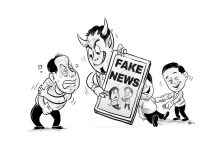
THE OBLATION statue of the University of the Philippines (UP) depicts a man facing upward with arms outstretched, symbolizing a selfless offering of oneself to his union.
UP was founded on June 18, 1908, or 117 years ago, through Act No. 1870 of the Philippine Assembly “to fill the need to meet the increasing demands for instruction in the higher levels of learning and provide professional studies in medicine, law, engineering or applied sciences.”
UP was to give “advanced instruction in literature, philosophy, the sciences and arts, and to give professional and technical training” to every qualified student regardless of “age, sex, nationality, religious belief and political affiliation.”
According to UP’s Bulletin No. 1, the University was seen as “the logical outgrowth and culmination of efforts made during the past ten years to establish a complete system of education for the Philippine islands.”
The University has a produced six out of the 17 Presidents of the Philippines; 16 out of 28 Chief Justices of the Supreme Court; a Pulitzer Prize awardee; two Pulitzer Prize finalists; 40 National Scientists; 44 National Artists; eight National Social Scientists; 14 out of 24 Senate Presidents; 14 out of 27 House Speakers; and tens of thousands of professionals like doctors, lawyers, engineers, teachers serving in the country and abroad.
As of 2023, two Americans and 20 Filipinos have served as UP Presidents. Ignacio Villamor (1915–21) and Jorge Bocobo (1934–39) became SC justices while Rafael Palma (1925–34) and Edgardo Angara (1981–87) became senators.
Entry to UP is highly selective through the UP College Admission Test (UPCAT), with thousands of applicants competing for limited slots across the university’s eight constituent units and 17 campuses.
A total of 17,996 applicants passed this year’s UPCAT translating to 13 percent of the 135,236 examinees, which is 6.74 percent higher than last year.
The UP Diliman campus was my solace for a decade as a student at the UP School of Economics (1987-91) and later at the UP College of Law (1992-98).
I belong to the 1,465 bar exam passers out of the 3,697 examinees (or 39.63%) in 1998, wherein three members of the batch landed as topnotchers for the 1998 bar exam.
One of the lines from the 2014 film “That Thing Called Tadhana” which starred Angelica Panganiban and JM de Guzman best described my stay in UP.
“Nung high school, sobrang galing ko. Lahat ng competitions na sinalihan ko, panalo ako. Tangina! Nu’ng pagdating ko ng UP, ang gagaling ng mga kaklase ko! May mga Malang, may Abueva. Akala ko magaling na ’ko e. Marunong lang pala.”
After Lantern Parade, the UP Fair is considered the biggest activity in UP Diliman that has evolved into a full-blown celebration of Philippine art, music and culture.
It has promoted several homegrown bands and talents, Eraserheads being one of the most famous. Buddy Zabala and Raymund Marasigan were my roommates for two years (1989 to 1991) at the Molave dorm.
College life is not confined in classrooms as Iskolars ng Bayan excel also in other fields like sports. UP recently hosted Season 87 of the University Athletic Association of the Philippines (UAAP).
UP earlier hosted UAAP 12 times for seasons 12 (1949–50), 16 (1953–54), 20 (1957–58), 26 (1963–64), 31 (1968–69), 36 (1973–74), 42 (1979–80), 46 (1983–84), 54 (1991–92), 62 (1999–2000), 71 (2008–09) and 78 (2015–16).
UP teams that emerged champions for Season 87 are basketball and athletics in the men’s division, and badminton for women’s division as well as street dance.
Season 87 is UP’s fourth championship title in Men’s Basketball after 1939 (Season 2), 1986 (Season 49) then in 2022 (Season 84).
UP is a microcosm of the larger society which is reflected in a slogan that appeared in the front page of the Philippine Collegian: “Kung hindi tayo kikibo, sino ang kikibo? Kung hindi tayo kikilos, sino ang kikilos? Kung hindi ngayon, kailan pa?”
During Martial Law, Philippine Collegian defied the media blackout by going underground, serving as voice of defiance and became part of the “mosquito press.”
Students have always been one of the largest, most vibrant forces of the social movements as Lean Alejandro once said: “The students are in a position to serve as catalysts in social transformation.”
All educational institutions, including UP, are safe havens for civilized and intelligent discourse of all beliefs and forms of democratic expression, where students and teachers can discuss freely without fear of censorship or retaliation.
The university teaches what textbooks cannot capture, the state education curriculum avoids, or the state authorities censor, erase or prohibit.
The campus molded us to fight for the causes we believe in; trained us for the skills we need to communicate ideas and rally others to effect changes in society.
As we cheer “UP Fight” in UAAP games, UP shall continue to exist with a critical eye on social and historical issues.
***
“Peyups” is the moniker of the University of the Philippines.
***
Atty. Dennis R. Gorecho heads the Seafarers’ Division of the Sapalo Velez Bundang Bulilan Law Offices. For comments, e-mail info@sapalovelez.com, or call 09175025808 or 09088665786./PN







